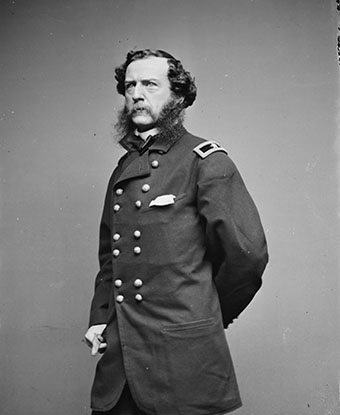Last updated: December 5, 2019
Person
Samuel W. Crawford

Library of Congress
Samuel Wylie Crawford, a US Army surgeon and a Union general during the Civil War, was one of the few individuals present at both the opening of the American Civil War at Fort Sumter and also at Appomattox Court House on April 9, 1865 when Confederate General Robert E. Lee's Army of Northern Virginia surrendered to Union General Ulysses S. Grant's Army of the Potomac, effectively ending the war. Despite his medical background, Crawford commanded a battery in the defense of Fort Sumter on April 12-13, 1861, providing his first taste of commanding men in battle. Later, as a commissioned Army officer, he fought in some of the most significant battles of the Eastern Theater, including the Battles of Antietam and Gettysburg. In 1887, he published his work on the start of the Civil War, The Genesis of the Civil War: The Story of Sumter, 1860-61, featuring the political events which led to the opening shots in Charleston Harbor.
Born in Pennsylvania, he studied at the University of Pennsylvania and later the University of Pennsylvania School of Medicine, graduating in 1850. In 1851, he joined the US Army as an assistant surgeon. Almost a decade later, on September 7, 1860 he received a telegram from the Adjutant General's Office of the War Department, directing that he "proceed forthwith to Fort Moultrie, South Carolina, and report for duty to the commanding officer of that station." He left an assignment in Newport, Rhode Island for the hotbed of Charleston, South Carolina, the city that soon became the cradle of secession. His arrival also coincided with the threat of a yellow fever outbreak; his predecessor at Fort Moultrie perished of the disease.
Of more concern than the danger of yellow fever for the US Army garrison at Fort Moultrie was the politics of South Carolina. After the election of President Abraham Lincoln, the arrival of Major Robert Anderson to take command of Fort Moultrie, and finally the secession of South Carolina, Anderson recognized the indefensible state of Fort Moultrie, ordering his men to evacuate and transfer to Fort Sumter the evening of December 26, 1860. Crawford, along with the other members of the US Army garrison at Fort Sumter, anxiously watched the South Carolinians and later Confederates surround their position with batteries on Sullivan's Island, Morris Island, and James Island.
When the Civil War erupted with Confederate fire on Fort Sumter in the early morning of April 12, 1861, Crawford commanded gun crews as they returned fire. A month after the fall of Fort Sumter, Crawford accepted a commision as a major in the 13th US Infantry. Later, as a brigadier general of volunteers in 1862, he led his men in the Department of the Shenandoah during Stonewall Jackson's Valley Campaign. His men did not see action until they were transferred to the Army of Virginia under Maj. Gen. John Pope. At the Battle of Cedar Mountain, Crawford's men suffered heavy casualties after initially driving back the Confederate left, including the Stonewall Brigade. About one month later, during the Maryland Campaign, Crawford suffered a wound in the right thigh while taking temporary command of his division at the Battle of Antietam. He stayed on the field until his worsening condition demanded he be removed. Eight months of recuperation followed. He returned to the field in May 1863, commanding the Pennsylvania Reserves division in the defenses of Washington DC.
In June 1863, his division would be transferred to the Army of the Potomac to help defend against another Confederate incursion into US held territory. The Gettysburg Campaign was at hand with Crawford, who had only commanded at the brigade level previously, commanding a division of men who had not seen combat for months. Fortunately for Crawford and his men, their role in the Battle of Gettysburg came at an opportune time and place. On July 2, he and his men arrived at Little Round Top to assist Col. Strong Vincent's brigade. Meanwhile Confederate Lt. Gen. James Longstreet's Corps had swept through Devil's Den, driving Union defenders back to a stream just west of Little Round Top. Crawford's division, along with the brigades of Colonels William McCandless and David J. Nevin, charged down the slopes of Little Round Top, driving the Confederates from the area. The successful charge met little Confederate resistance and led Crawford to believe he was the savior of the Battle of Gettysburg. During the charge, he personally took the division's colors from a sergeant to lead the division. Crawford's experience on July 2, 1863 stayed with him, contributing to his ego and spurring his leadership to preserve the battlefield.
Crawford remained in command of the Pennsylania Reserves Division for the remainder of the war, commanding them during the Richmond-Petersburg Campaign. At the end of the Siege of Petersburg, Crawford's division got disoriented in the woods at the Battle of Five Forks, wandering away from the Confederate left which they were meant to attack. Maj. Gen. Gouverneur K. Warren, commander of the V Corps, personally rode out to retrieve Crawford's division. Warren's absence during the attack and failure to control Crawford's movements led Maj. Gen. Philip Sheridan to relieve Warren, ultimately resulting in a post-war inquiry into Warren's conduct. The inquiry took place in 1879 and found Warren's dismissal unjustified.
Crawford retired from the Army in 1873 and spent his final years on his book, dying in 1892.
